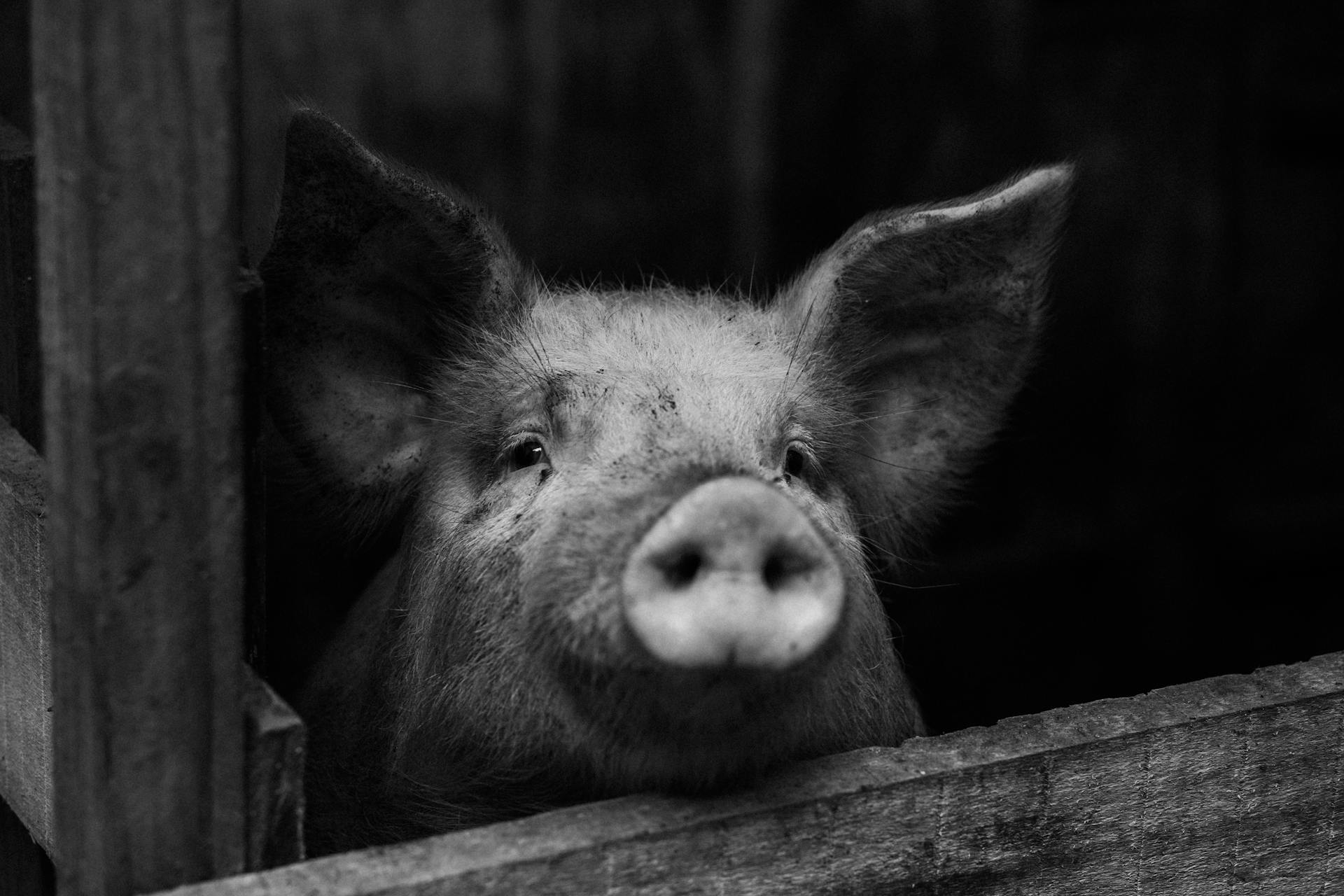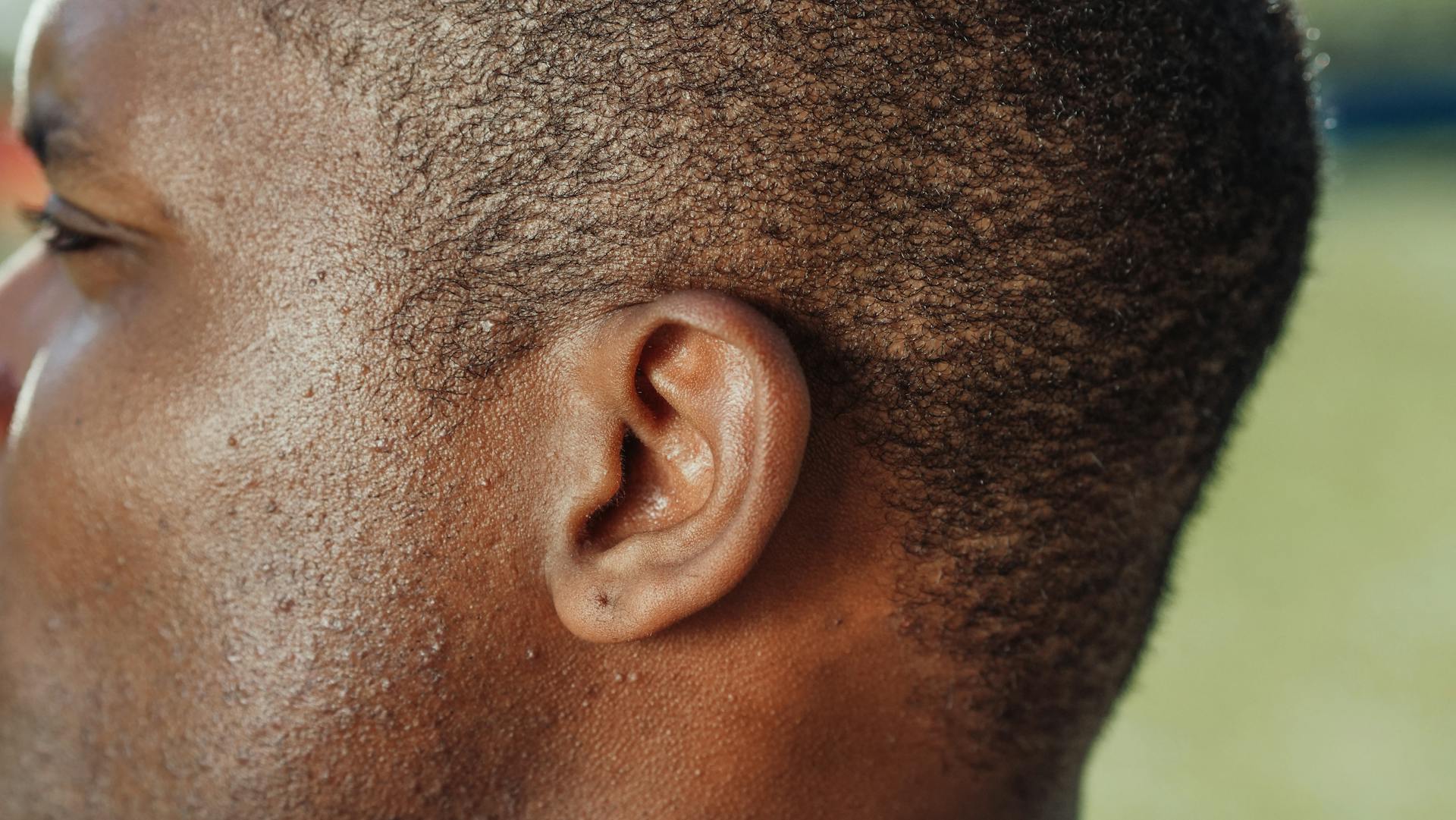
Ear cropping is a surgical procedure that involves cutting and trimming the ears of a dog to prevent infections and improve their overall health. This process can be done for both aesthetic and health reasons.
The American Veterinary Medical Association recommends that ear cropping be done by a veterinarian, as it requires a high level of skill and precision. In fact, ear cropping is considered a veterinary procedure that should only be performed by a licensed veterinarian.
Most veterinarians agree that ear cropping should be done when a puppy is between 6 to 12 weeks old, as this is the ideal age for the surgery to be performed safely and effectively. This age range allows for the best healing results and minimizes the risk of complications.
Additional reading: Doberman Ear Cropping Age
Why Do People Crop Dogs' Ears?
People crop dogs' ears for a variety of reasons, some of which date back to ancient times. In Roman times, ear cropping was done to make fighting dogs less likely to be injured.
Tradition is still a big reason people crop their dogs' ears today. Many breeders feel they have to crop their puppies' ears to meet breed standards and give them a chance in the show ring.
Some people believe ear cropping can prevent ear infections later in life, but many vets say this is a misguided belief with no definitive evidence. There is no evidence that natural ears cause ear infections.
Historically, shepherds cropped herding dogs to prevent swelling and infections of the ear. They also believed dogs could hear better without ear flaps.
The look of cropped ears is often preferred by some people, who find it makes their dog look tough or wolf-like. This is especially true for breeds like the Miniature Pinscher and Brussels Griffon, which were developed to be barn ratters.
In the past, some breeds like the Boxer had their ears cropped to improve their hearing for working roles like police dogs and seeing-eye dogs. However, there's no evidence that ear cropping enhances a dog's hearing.
The closely cropped look of some breeds has become synonymous with toughness, an attribute admired by fans of those breeds. This is why some breeders continue to crop the ears of breeds like the American Pit Bull Terrier and American Staffordshire Terrier.
Intriguing read: When Is It Too Late to Crop a Dog's Ears?
Veterinarians and the Ear Cropping Process
There are veterinarians in most states who still provide ear cropping services.
Any surgery is painful, and proper veterinary care can help mitigate this and the risk for infection.
Do your research, talk with your veterinarian, or seek a few opinions beforehand.
Legal Considerations
Ear cropping is now considered an elective and cosmetic procedure, not necessary for a dog's health.
Many countries and breed associations have banned the surgery, including Germany where it likely originated.
The American Veterinary Medical Association (AVMA) does not support ear cropping for cosmetic purposes due to the unnecessary risk to the animal.
The American Kennel Club and Canadian Kennel Club, however, still support the practice and allow registration and showing of cropped dogs.
In some cases, ear cropping is performed at home with scissors, which is painful and can have catastrophic consequences.
This is why it's essential to discuss the risks with your veterinarian extensively before pursuing the surgery.
The risks of surgery and anesthesia should be carefully considered before proceeding with ear cropping.
For more insights, see: American Bulldog Ear Cropping
Veterinarians Offering Services
Veterinarians who offer ear cropping services can be found in most states. These veterinarians prioritize proper care to minimize pain and distress to the animal.
Any surgery, including ear cropping, is painful and carries a risk of infection. Do your research and talk to a veterinarian before making a decision.
There are veterinarians who are willing to discuss the pros and cons, risks, and aftercare of ear cropping with you. They can also evaluate your puppy for surgery.
However, not all veterinarians offer ear cropping services, and some may not be willing to discuss the procedure with you.
See what others are reading: Doberman Pinscher Ear Surgery
Understanding the Ear Cropping Process
Ear cropping is typically done when a puppy is between 6 and 12 weeks of age, although some breeds like Boston Terriers undergo cropping when fully grown.
The procedure is usually performed by a veterinarian under general anesthesia, but some breeders or individuals claim to be able to do it at home. Administering analgesia, or pain medication, is essential to minimize discomfort during the procedure.
The ear pinna is very sensitive and contains many nerve endings, which is why postoperative pain management is crucial. The ear is shaved and scrubbed with antibacterial soap before surgery, and the cut edges are sutured and bandaged.
Things to Know Going Forward
Ear cropping typically occurs between 8-12 weeks of age, when puppies are capable of enduring anesthesia safely.
The cartilage in a puppy's ears begins to harden and adopt its permanent shape around 12 weeks of age, so waiting much later than this can make the process more complicated.
Following surgery, the ears of most breeds and most crop styles must be trained or formed to stand up, which requires special bandaging and bracing.
You can expect to make extra vet visits for bandage changes, which may be weekly or more, depending on the method of training or bracing the ears.
The incisions from ear cropping take a few weeks to heal, and then the sutures can be removed.
Depending on the method of training or bracing, your puppy may be at an increased risk for ear infections during this time.
There are multiple styles of ear crop, so it's essential to know what you want for your dog before the surgery takes place, as there's no do-over in most cases.
Expand your knowledge: Dog Ear Grooming
What Is?
Ear cropping is a surgical procedure performed by vets on puppies, usually between 6 and 12 weeks old.
The surgery takes about half an hour to complete, and it's a fairly straightforward process.
Vets administer anesthesia to sedate the animal before starting the procedure.
The vet then uses a scalpel or laser to cut away the undesirable portion of the ear.
After removing the excess ear flap, the vet tapes the remaining portion of the ear in a way that keeps it upright.
This is done to maintain the correct ear position during the healing process.
Bandages are removed and reapplied weekly for 4 to 8 weeks until the ears fully heal.
Most puppies have to wear an Elizabethan collar for a few weeks to prevent them from messing with their ears and causing infection or improper wound healing.
For more insights, see: After Ear Cropping Care
Dogs' Ears
Dogs' ears are quite fascinating, and their ear cropping process is a significant aspect of their grooming. Ear cropping is typically done when a puppy is between 6 and 12 weeks of age.
Some breeds, like the Miniature Pinscher and Brussels Griffon, historically had their ears cropped to minimize the risk of injury to the ear pinna. This practice was more common when they were used as barn ratters.
The most common reason for cosmetic ear cropping is to honor or replicate a putative function, but some breeders continue this practice even though their breeds are now used as companion animals. The closely cropped look has become synonymous with toughness.
Breeds like the Boxer, which developed as working dogs, traditionally had their ears cropped to improve their hearing. However, there is no evidence that ear cropping enhances a dog's hearing.
The ear cropping procedure involves shaving and scrubbing the puppy's ears with antibacterial soap before surgery. The pinnas are then trimmed to the desired shape and size using a scalpel, surgical scissors, and/or a laser.
A veterinarian typically performs the surgery under general anesthesia, administering analgesia to minimize discomfort. However, some breeders crop their puppies' ears at home without proper pain management or cleanliness standards.
Regardless of who performs the ear cropping procedure, there is potential for post-operative complications, including infection and pain. The surgical site can become itchy and irritated, causing the dog to scratch at its ears and leading to additional trauma.
You might enjoy: Dogs Ears Cropped
Most breeds require a significant amount of after-care, including regular bandage changes and the use of an Elizabethan collar to protect the surgery sites. This can be a challenge, especially for young, active puppies.
Ear cropping typically occurs between 8-12 weeks of age, and the ears of most breeds must be trained or formed to stand up after the surgery. This requires special bandaging and bracing, which may require bandage changes weekly or more.
The incisions take a few weeks to heal, and then the sutures can be removed. Depending on the method of training or bracing the ears, the puppy can be at an increased risk for ear infections during this time.
Benefits and Proper Care
Proper care after ear cropping is crucial for a smooth recovery. Keeping the incision site clean and dry is essential to prevent infection.
To reduce swelling, apply a cold compress to the affected area for 10-15 minutes, 3-4 times a day. This will also help to minimize discomfort.
Regular check-ups with your veterinarian are necessary to ensure the incision site is healing properly. They will also monitor for any signs of complications.
What's in Dogs?

Ear cropping is a surgical procedure that alters a dog's ear shape by cutting away the outer ear, typically performed on puppies between 6-12 weeks old. This is usually done to achieve a specific appearance and is extremely uncommon in mixed-breed dogs.
The procedure is most commonly performed on breeds like Doberman Pinschers, Great Danes, Mastiffs, and Pit Bull Terriers. Doberman and Great Dane ears are often left long and pointed, while "Bully" breeds like Pit Bull Terriers frequently have very little of their outer ear left.
A licensed veterinarian should always perform ear cropping under general anesthesia to minimize pain and discomfort. In some cases, unscrupulous breeders may crop ears at home without proper pain control, which is not recommended.
Expand your knowledge: Ear Cropping for Great Danes
Properly Standing Ears
Properly standing ears are crucial for the health and appearance of your dog. Cropped ears that are not standing properly must not be left out of tapes other than for an "airing".

For every day ears are untaped, you add an extra week of taping, so it's essential to keep them taped correctly. Georgia's Regular Ear Taping Method is a great resource for learning how to properly tape your dog's ears.
It's not uncommon for owners to experience difficulties finding ear taping supplies at their local drug store, but most can be purchased through Amazon. Your breeder or taper can give you recommendations on what supplies to purchase.
A mentor once shared with me that if one method of ear taping isn't giving the results you want, try another. The main criteria for taping is that it is done correctly.
Curious to learn more? Check out: Doberman Pinscher Ear Taping
Frequently Asked Questions
How long does it take for cropped ears to heal?
Healing time for cropped ears typically takes 2-4 weeks, with a 2-week period of limited activity and no bathing or swimming. Suture removal is usually required 14 days after the procedure.
How long do stitches stay in after ear cropping?
Stitches from ear cropping surgery are typically removed in two stages: the first set 7 days after surgery, and the second set 10 days post-op
Are dogs put to sleep for ear cropping?
Yes, ear cropping in dogs typically requires full anesthesia, ensuring the dog is safely sedated during the procedure. This ensures a pain-free experience for the dog.
Featured Images: pexels.com
